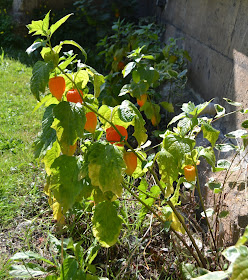5 September 2013
1-2 hours
If in Newbury with
a couple of hours to spare in September it is worth seeking out the wasteland
flowers.
We started at the most productive
site, the station car-park, handy whether arriving by train or car. We immediately spotted Oxford ragwort Senecio squalidus [South Europe] with
its lax umbels of flowers larger than common ragwort, along with redleg Persicaria maculosa, annual mercury Mercurialis annua, weld Reseda luteola and thyme-leaved sandwort
Arenaria serpyllifolia, right next to
the station platform.
Beside these was a
single clump of rough bristle-grass Setaria
verticillata [also from warmer climes to the east].
Rough bristle-grass
Immediately then
came the first of many Bilbao 's fleabanes Conyza floribunda [South
America ]. Similar to
Canadian fleabane, the latter has red-streaked roughly hairy stems (the
quickest field character) and (with a good lens) 5-lobed disc-flowers (4 in C. canadensis). While Canadian fleabane was at one time the
commonest of these Conyza species,
here at least Bilbao's has become dominant, to the extent that we could not
find any canadensis here at all, nor
in other parts of central Newbury. Bilbao 's fleabane was first recorded in this car-park in
2001 (Crawley 's Flora of Berkshire) and has
thus become thoroughly naturalised.
A bank across the
car-park had fennel Foeniculum vulgare
[Europe], wild carrot Daucus carota,
hemp-agrimony Eupatoria cannabinum,
Canadian goldenrod Solidago canadensis [North
America], and purple toadflax Linaria
purpurea [Italy
Erigeron acer ssp serotinus
Blue fleabane ssp acer
This bank by the
car-park and others on the far north side were dominated by a strange tall
white-woolly mullein with large yellow flowers.
This was Broussa mullein Verbascum
bombyciferum [Turkey ],
first recorded at this very site in 2004 (Crawley 's
Flora of Berkshire). Apart from its odd
appearance, the species has narrow spathulate stigmas and the anthers on the two
"lower" stamens running down on to the stamen rather than being sat
crosswise on top like the other three.
(Stace uses "lower" but this refers to the position in the
flower and not to their length, as these two stamens tend to be taller than the
others - very confusing!)
Broussa mullein
Algerian ivy
The warm
micro-climate of the car-park, apart from favouring these plants from warmer
climates, was also popular with field grasshoppers Chorthippus brunneus.
Field grasshopper among
young plants of Broussa mullein
Leaving at the
west end of the car-park we crossed into Bartholomew Street Crawley 's
Flora of Berkshire as abundant here in 2001, but there were now just a few
plants. The same source only gives the
meadow-rue for a rubbish-tip in Newbury in 1961, so this is a new addition to
the churchyard. Autumn crocus Crocus nudiflorus is recorded here but
we were too early to see any, even if it does survive.
Japanese lantern
We then crossed
the market-square to the east and wended our way through other car-parks back
to the station. The only fleabane we saw
other than Bilbao 's was one very large clump of
Guernsey fleabane Conyza sumatrensis [South America ] beside one wall, growing with buddleia Buddleja davidii. Apart from being tall and bushy this fleabane
is conspicuously hairy. This made it a
three-fleabane day, four if one counts the possible hybrid. It also completed our tour of the world
inside one square kilometre.











You captured Erigeron acris subsp. serotinus (Weihe) Greuter, not a hybrid fleabane.
ReplyDelete